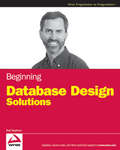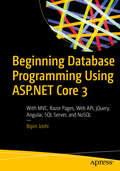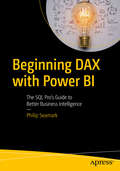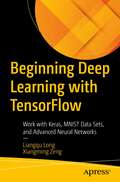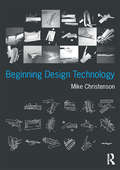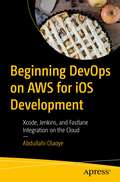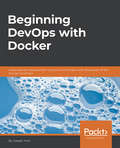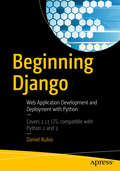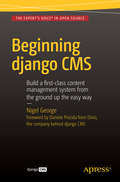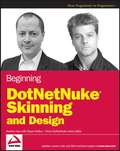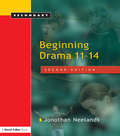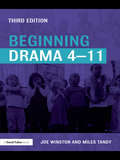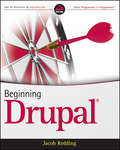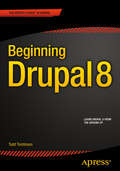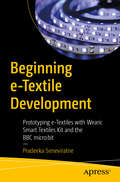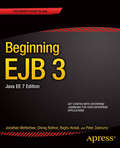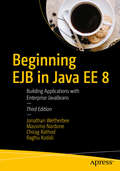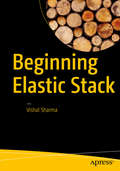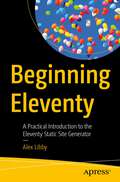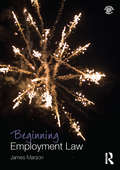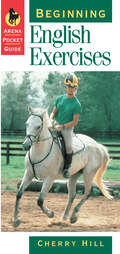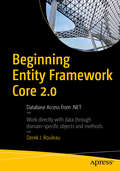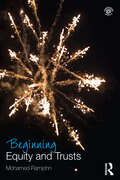- Table View
- List View
Beginning Database Design Solutions
by Rod StephensThe vast majority of software applications use relational databases that virtually every application developer must work with. This book introduces you to database design, whether you're a DBA or database developer. You'll discover what databases are, their goals, and why proper design is necessary to achieve those goals. Additionally, you'll master how to structure the database so it gives good performance while minimizing the chance for error. You will learn how to decide what should be in a database to meet the application's requirements.
Beginning Database Programming Using ASP.NET Core 3: With MVC, Razor Pages, Web API, jQuery, Angular, SQL Server, and NoSQL
by Bipin JoshiHit the ground running with this book to quickly learn the fundamentals of HTML form processing, user authentication, and database CRUD (Create, Read, Update, and Delete) operations using the ASP.NET Core family of technologies. You will utilize cutting-edge and popular technology options from both the server side and client side to help you achieve your web application goals as quickly as possible. Developers who want to learn ASP.NET Core and complementary technologies are often overwhelmed by the large number of options involved in building modern web applications. This book introduces you to the most popular options so that you can confidently begin working on projects in no time. You will learn by example, building a sample application that demonstrates how the same application can be built using different options. This experiential approach will give you the basic skills and knowledge to understand how the options work together so that you can make an informed decision about the available choices, their trade-offs, and code level comparison. After reading this book, you will be able to choose your selected learning path. What You Will LearnDevelop data entry forms in ASP.NET Core, complete with validations and processingPerform CRUD operations using server-side options: ASP.NET Core MVC, Razor Pages, Web APIs, and BlazorPerform CRUD operations using client-side options: jQuery and AngularSecure web applications using ASP.NET Core Identity, cookie authentication, and JWT authenticationUse RDBMS and NoSQL data stores: SQL Server, Azure SQL Database, Azure Cosmos DB, and MongoDB for CRUD operationsDeploy ASP.NET Core web applications to IIS and Azure App Service Who This Book Is ForDevelopers who possess a basic understanding of ASP.NET and how web applications work. Some experience with Visual Studio 2017 or higher, C#, and JavaScript is helpful.
Beginning DAX with Power BI: The SQL Pro’s Guide to Better Business Intelligence
by Philip SeamarkAttention all SQL Pros, DAX is not just for writing Excel-based formulas! Get hands-on learning and expert advice on how to use the vast capabilities of the DAX language to solve common data modeling challenges. Beginning DAX with Power BI teaches key concepts such as mapping techniques from SQL to DAX, filtering, grouping, joining, pivoting, and using temporary tables, all aimed at the SQL professional. Join author Philip Seamark as he guides you on a journey through typical business data transformation scenarios and challenges, and teaches you, step-by-step, how to resolve challenges using DAX. Tips, tricks, and shortcuts are included and explained, along with examples of the SQL equivalent, in order to accelerate learning. Examples in the book range from beginner to advanced, with plenty of detailed explanation when walking through each scenario. What You’ll Learn Turbocharge your Power BI model by adding advanced DAX programming techniquesKnow when to use calculated measures versus calculated columnsGenerate new tables on the fly from existing dataOptimize, monitor, and tune Power BI to improve performance of your modelsDiscover new ideas, tricks, and time-saving techniques for better models Who This Book Is For Business intelligence developers, business analysts, or any SQL user who wants to use Power BI as a reporting tool. A solid understanding of SQL is recommended, as examples throughout the book include the DAX equivalents to SQL problem/solution scenarios.
Beginning Deep Learning with TensorFlow: Work with Keras, MNIST Data Sets, and Advanced Neural Networks
by Liangqu Long Xiangming ZengIncorporate deep learning into your development projects through hands-on coding and the latest versions of deep learning software, such as TensorFlow 2 and Keras. The materials used in this book are based on years of successful online education experience and feedback from thousands of online learners. You’ll start with an introduction to AI, where you’ll learn the history of neural networks and what sets deep learning apart from other varieties of machine learning. Discovery the variety of deep learning frameworks and set-up a deep learning development environment. Next, you’ll jump into simple classification programs for hand-writing analysis. Once you’ve tackled the basics of deep learning, you move on to TensorFlow 2 specifically. Find out what exactly a Tensor is and how to work with MNIST datasets. Finally, you’ll get into the heavy lifting of programming neural networks and working with a wide variety of neural network types such as GANs and RNNs. Deep Learning is a new area of Machine Learning research widely used in popular applications, such as voice assistant and self-driving cars. Work through the hands-on material in this book and become a TensorFlow programmer! What You'll LearnDevelop using deep learning algorithmsBuild deep learning models using TensorFlow 2Create classification systems and other, practical deep learning applicationsWho This Book Is ForStudents, programmers, and researchers with no experience in deep learning who want to build up their basic skillsets. Experienced machine learning programmers and engineers might also find value in updating their skills.
Beginning Design for 3D Printing
by Joe MicallefBeginning Design for 3D Printing is the full color go-to-guide for creating just about anything on a 3D printer. This book will demystify the design process for 3D printing, providing the proper workflows for those new to 3D printing, eager artists, seasoned engineers, 3D printing entrepreneurs, and first-time owners of 3D printers to ensure original ideas can be 3D printed. Beginning Design for 3D Printing explores a variety of 3D printing projects. Focus is on the use of freely available 3D design applications with step-by-step techniques that will demonstrate how to create a wide variety of 3D printable objects and illustrate the differences between splines, polygons, and solids. Users will get a deep understanding of a wide range modeling applications. They'll learn the differences between organic modeling tools, hard edge modeling, and precision, CAD-based techniques used to make 3D printable designs, practical products, and personalized works of art. Whether you are a student on a budget or a company exploring R & D options for 3D printing, Beginning Design for 3D Printing will provide the right tools and techniques to ensure 3D printing success. What you'll learn Learn the differences between the software modeling tools available for 3D printing. Understand the fundamental design concepts and definitions in the 3D modeler's toolkit. Learn the best tool for the project, and how to design 3D printable objects quickly and efficiently. Learn the differences between organic, hard edged, and precision based CAD techniques Avoid common design errors and mistakes that can lead to frustration. Ensure cost-efficient designs through optimization techniques. Create a range of objects from simple every-day designs to complex, articulated assemblies that are printable Gain an understanding of advanced procedures that exemplify how, in 3D printing, "design complexity is free". Who this book is for Beginning Design for 3D Printing is for anyone interested in essential 3D printing design techniques. This book is intended for artists, designers, engineers, students and entrepreneurs wanting to create their own original content for 3D printing. Table of Contents Chapter 1: What's Possible With 3D Printing? Chapter 2: Exploring Design Techniques for 3D Printing Chapter 3: Begin With a Box Chapter 4: Preparing the Box for 3D Printing Chapter 5: Creative Applications for Simple Shapes Chapter 6: Design Strategies for 3D Printing Chapter 7: Basic Solid Modeling Techniques Chapter 8: Organic Modeling Techniques Chapter 9: Customization Techniques Chapter 10: 3D Scanning Techniques Chapter 11: Intermediate Solid Modeling Techniques for Mechanical Connections Chapter 12: Advanced Techniques Using Blender Chapter 13: Working With 3D Printing Service Bureaus Appendix: Timeline of 3D Printing Design Milestones
Beginning Design Technology
by Mike ChristensonBeginning Design Technology introduces how design technologies work together, including tools, materials, and software, such as Adobe Photoshop, Adobe Illustrator, Autodesk AutoCAD, and others. It teaches you how to think about each design tool, whether a software program or physical modelmaking, so that you will select one for its strengths for a specific task and know when and how to combine it with other tools. Topics include working with building information, texturing digital and physical artifacts, translating information from one form or file format to another, constructing at full-scale, and making digital and physical models. Chapter Summaries, exercises, discussion questions, a glossary, an appendix of common software commands, and an annotated bibliography will help you find what you need quickly and put the information into practice.
Beginning DevOps on AWS for iOS Development: Xcode, Jenkins, and Fastlane Integration on the Cloud
by Abdullahi OlaoyeApply the principles of DevOps in software development—automated builds, automated tests, and continuous deployment and delivery—to iOS application development on Amazon Web Services (AWS) cloud. This book provides detailed walkthroughs and example source code is provided for the concepts discussed so you can put theory into practical application.You'll start by building a basic iOS application and then dive deep into key AWS Developer tools and services to see how they can be used in iOS application development. Then review the details of the integration of these fully managed AWS services with open-source tools such as Jenkins and Fastlane that allow developers to get the best of both worlds and further help to enhance and increase agility in the development lifecycle of iOS apps. You'll also investigate the Amazon EC2 Mac instance, which allows you to run XCode in a cloud environment for the first time to leverage the flexibility, elasticity, and scale of AWS. It also allows for seamless integration of XCode with fully managed AWS Services from source code control to application deployment. Finally, the book covers how a fully managed Continuous Integration Continuous Deployment (CICD) pipeline can be used to orchestrate all the different components of iOS application development to achieve a fully automated development lifecycle. Get started building your iOS applications using a fully automated process on the AWS Cloud today!What You'll LearnBuild an iOS application using AWS DevOps tools Incorporate continuous deployment in your iOS application development Integrate AWS tooling with Xcode and open source tools such as Jenkins and FastlaneWho This Book Is ForiOS application developers wanting to incorporate DevOps and Cloud Architecture into their development process.
Beginning DevOps with Docker: Automate the deployment of your environment with the power of the Docker toolchain
by Joseph MuliAutomate the deployment of your environment with the power of the Docker toolchainKey Features Written and reviewed by expert Docker developers The book precisely covers all the essential topics such as building images and managing container swarms required in day to day use for Docker The book includes activities on the docker CLI and exercises such as writing Dockerfiles for Python which will allow you to reinforce the concepts coveredBook DescriptionDevOps with Docker outlines the power of containerization and the influence this innovation has on development teams and general operations. We also get to understand what DevOps really is, the principles involved and how the process contributes to product health, by implementing a Docker workflow. We will learn to interpret Dockerfile syntax, build images and set up containers and images. In addition, we will deploy a Docker image to the Docker Hub. Docker is an open source containerization tool, that makes it easier to streamline product delivery. It helps reduce the time taken to get from a whiteboard sketch of the business to a money-back implementation.This fast-paced book is a perfect amalgamation of theory and hands-on exercises. The book will take you through the basics of Docker and DevOps and why and how they integrate. You will then understand what containers are, and how to create and manage them. Next, we will work on the docker-compose file and CLI. Then we will move to set up a network with the docker-compose tool. Gradually you will learn how to scale a delivery pipeline and multiple deployments with Docker. Lastly, you will grasp the concept of orchestration and learn to implement the delivery of containerized applications.What you will learn Understand how to effectively design and build containers for different applications Set up an environment for testing, avoiding environment mismatch that is breaking production Set up and manage a multi-tier environment. Run, debug, and experiment with applications in a containerWho this book is forThe book is crafted for developers, system architects, junior and mid-level site reliability engineers interested in adapting a docker workflow. They are also required to have a basic knowledge of UNIX concepts such as ssh, ports and logs.
Beginning Django: Web Application Development and Deployment with Python
by Daniel RubioDiscover the Django web application framework and get started building Python-based web applications. This book takes you from the basics of Django all the way through to cutting-edge topics such as creating RESTful applications. Beginning Django also covers ancillary, but essential, development topics, including configuration settings, static resource management, logging, debugging, and email. Along with material on data access with SQL queries, you'll have all you need to get up and running with Django 1. 11 LTS, which is compatible with Python 2 and Python 3. Once you've built your web application, you'll need to be the admin, so the next part of the book covers how to enforce permission management with users and groups. This technique allows you to restrict access to URLs and content, giving you total control of your data. In addition, you'll work with and customize the Django admin site, which provides access to a Django project's data. After reading and using this book, you'll be able to build a Django application top to bottom and be ready to move on to more advanced or complex Django application development. What You'll Learn Get started with the Django framework Use Django views, class-based views, URLs, middleware, forms, templates, and Jinja templates Take advantage of Django models, including model relationships, migrations, queries, and forms Leverage the Django admin site to get access to the database used by a Django project Deploy Django REST services to serve as the data backbone for mobile, IoT, and SaaS systems Who This Book Is For Python developers new to the Django web application development framework and web developers new to Python and Django.
Beginning django CMS
by Nigel GeorgeBuild a world-class website in less than a week with Django CMS. Beginning Django CMS shows you how to simply and easily write a dynamic website with a full content management system in the backend. It is written for Internet developers who are sick and tired of dealing with complicated, bloated website frameworks that are a pain to build and a nightmare to maintain. Django CMS is an Open Source website building framework that is experiencing exponential growth because it is built on the simple, secure and scalable architecture of Django. This book takes you from knowing nothing about Django CMS, to building a functional website and content management system that you can deploy for your own website or for your customers. What you'll learn How to build a dynamic website quickly and easily How to author and submit content for publication How to administer Django CMS How to install and use custom and third-party plugins How to deploy a website using Django CMS Who this book is for Programmers, in particular Python and Django programmers, wishing to build a simple, custom content management system (CMS). They do not have to be directly interested in the Django CMS application, Beginning Django CMS will be equally useful to a programmer looking to build a functioning CMS rapidly. Table of Contents 1. Working With a CMS 2. Installing Django CMS 3. Introduction to Django CMS 4. Site Templates 5. Your Blog Website: Templates 6. Django CMS: Plugins 7. Advances Plugins 8. Authoring in Django CMS 9. Menus and Navigation 10. Extending Django CMS 11. Next Steps
Beginning DotNetNuke Skinning and Design
by Andrew Hay Shaun WalkerDotNetNuke is an open source framework built on top of the ASP.Net platform. While this system offers an impressive set of out-of-the-box features for public and private sites, it also includes a compelling story for folks who want to present a unique look and feel to visitors.The skinning engine inside of DotNetNuke has strengthened over the course of several years and hundreds of thousands of registered users. The success of its skin and module developer community is another key indicator of the depth and breadth of this technology. The Core Team responsible for the DotNetNuke brand has gone to great lengths to enable a predictable and positive experience for both the visitors of the site and the developers who build them.Note: CD-ROM/DVD and other supplementary materials are not included as part of eBook file.
Beginning Drama 11–14
by Jonothan NeelandsThis guide explores the roles, skills and knowledge needed to become an effective drama teacher. It combines practical advice on planning, teaching and assessing with the best teaching practices. It also offers lesson plans for years 7-9 students to use intheir teaching.
Beginning Drama 4-11
by Joe Winston Miles TandyThis third edition of Beginning Drama 4-11 is fully updated and revised in light of the renewed Framework for Teaching Literacy, and provides an introduction for early years and primary school teachers who are new to drama and for student teachers who wish to specialise in the teaching of drama. It offers step-by-step guidance to help teachers and children grow in confidence in their use of drama, and shows clearly how drama can contribute to work in English, and learning across the curriculum, as well as to the broader cultural life of the school. The authors have an international profile and this third edition builds on the work's reputation of as one of the most accessible texts on primary drama available.
Beginning Drupal
by Jacob ReddingA thorough introduction that lessens the learning curve to building sites with Drupal 7 Drupal 7 is the latest version of the free, open source content management system Drupal. A powerful content management system and framework Drupal has an unfortunate reputation of having a steep learning curve. This guide to Drupal 7 methodically demystifies Drupal and shortening the learning curve. Author Jacob Redding is deeply embedded in the Drupal community, and walks first-time Drupal developers through the installation and configuration of a Drupal system. In-depth information on key areas of Drupal explore the Drupal hook system, Drupal's theming layer, and Drupal's API. You'll also get sample code, and lessons that guide you through various aspects of Drupal. Introduces you to every aspect of Drupal 7 Demystifies key areas of Drupal and shortens the learning curve for even the most novice beginner Features lessons and sample code that offer extra insight into a Drupal web site Exploring simple single website installations and more advanced multiple site installations that share users and/or content. Addresses how to use Drupal's theming layer to your advantage. With this comprehensive and clear book by your side, you will quickly learn to leverage Drupal's impressive power. Note: CD-ROM/DVD and other supplementary materials are not included as part of eBook file.
Beginning Drupal 8
by Todd TomlinsonBeginning Drupal 8 teaches you how to build, maintain, and manage Drupal 8-based web sites. The book covers what Drupal is, using Drupal when building a new web site, installing and configuring Drupal, creating and managing content, managing users, adding functionality to your web site through Drupal modules, and advanced topics on using themes, panels, and views. The book also builds practical examples of common Drupal sites, such as a company website, a community website, and a commerce website, that you can take and expand on to create your own Drupal 8 sites. By reading this book, you will understand the power of the Drupal platform, and why you should be using Drupal if you're not already. Through following the samples in the book, you will quickly build your confidence and your ability to use Drupal. Beginning Drupal 8 gives you the knowledge necessary to build, deploy, and manage web sites on Drupal 8. What you'll learn What Drupal is and why you should use it How to install a basic Drupal web site from scratch How to create content in your new Drupal web site How to manage users on your new Drupal web site How to change the look and feel of your new Drupal web site through themes How to install and configure modules Who this book is for This book is for nontechnical users who want to use Drupal 8 to manage content, as well as developers who are new to Drupal 8. Table of Contents Introduction to Drupal Creating and Managing Content Creating and Managing Users Creating and Using Taxonomy Creating Content Types Creating and Using Views Creating and Using Page Payouts Creating and Using Menus Creating and Using Blocks Theming Your Site Making Your Site Responsive Extending Your Site Through Contributed Modules The Anatomy of a Module Using Multilingual Administering Your Drupal Site Using Drush Using Git Putting It All Together Building a Blog Site Building a Company Website Building a Community Website Building a Commerce Website App A: Modules App B: Learn More
Beginning e-Textile Development: Prototyping e-Textiles with Wearic Smart Textiles Kit and the BBC micro:bit
by Pradeeka SeneviratneElectronic textiles (e-textiles) involves the combination of electronics and textiles to form "smart" textile products. It is an emerging technology with immense opportunities in the field of wearables fashion technology. And while there are many e-textile development platforms available on the market, this book uses the Wearic smart textile kit, a modular prototyping platform, to get you building projects and experiments easily and quickly.This book presents the essential skills required to get started developing e-textiles. The code presented is built using MakeCode blocks, an easy-to-use visual programming language. You'll use the BBC micro:bit microcontroller for all the projects, and with few exceptions, they require no soldering and wiring. In the end, you'll be able to apply and sew electronics to wearables, garments, and fabrics in this emerging technology.Beginning e-Textile Development presents the essential components to get you started with developing e-textiles. What You'll LearnProgram with the BBC micro:bitAdd lights to your wearables using LED textilesUse different textile sensors to measure heat, detect water, actuate attachments, and enable sense touch and pressureActuate attachments on wearables with muscle activity and heartbeatMake chemistry-based color-changing fabrics using thermochromic pigmentsUtilize Bluetooth Low Energy to send sensor data to mobile apps and WiFi to send sensor data to the ThingSpeak IoT analytics platform serviceWho This Book Is ForBeginners to the e-textile industry seeking a comprehensive toolkit. Fashion designers, Makers, engineers, scientists, and students can all benefit from this book.
Beginning EJB 3: Java EE 7 Edition (Beginning: From Novice To Professional Ser.)
by Jonathan Wetherbee Chirag Rathod Raghu Kodali Peter ZadroznyDevelop powerful, standards-based, back-end business logic with Beginning EJB 3, Java EE 7 Edition. Led by an author team with 20 years of combined Enterprise JavaBeans experience, you'll learn how to use the new EJB 3. 2 APIs. You'll gain the knowledge and skills you'll need to create the complex enterprise applications that run today's transactions and more. Targeted at Java and Java EE developers, with and without prior EJB experience, Beginning EJB 3 is packed with practical insights, strategy tips, and code examples. As each chapter unfolds, you'll not only explore a new area of the spec; you'll also see how you can apply it to your own applications through specific examples. Beginning EJB 3 will serve not only as a reference, but it will also function as a how-to guide and repository of practical examples to which you can refer as you build your own applications. It will help you harness the power of EJBs and take your Java EE 7 development to the next level. What you'll learn How to employ session beans, message-driven beans, and entity beans How to use the updated EJB 3 persistence and object-relational mappings How to choose which EJB option is right for your application How to enrich your application's behavior with CDI services How to test the EJB container inside and out How to migrate from older EJB to the newest EJB APIs Who this book is for This book is for those Java and Java EE developers with and without prior EJB experience. Table of Contents Introduction to the EJB 3 Architecture Session Beans Entities and the Java Persistence API Advanced Persistence Features Message-Driven Beans EJB and Web Services Integrating Session Beans, Entities, Message-Driven Beans, and Web Services Transaction Management EJB Performance and Testing Context and Dependency Injection (CDI) Packaging and Deployment EJB Client Applications EJB Runtime Environments
Beginning EJB in Java EE 8: Building Applications With Enterprise Javabeans
by Raghu Kodali Chirag Rathod Massimo Nardone Jonathan WetherbeeBuild powerful back-end business logic and complex Enterprise JavaBeans (EJB)-based applications using Java EE 8, Eclipse Enterprise for Java (EE4J), Web Tools Project (WTP), and the Microprofile platform. Targeted at Java and Java EE developers, with or without prior EJB experience, this book is packed with practical insights, strategy tips, and code examples. As each chapter unfolds, you'll see how you can apply the new EJB spec to your own applications through specific examples.Beginning EJB in Java EE 8 serves not only as a reference, but also as a how-to guide and repository of practical examples to which you can refer as you build your own applications. It will help you harness the power of EJBs and take your Java EE 8 development to the next level. You'll gain the knowledge and skills you’ll need to create the complex enterprise applications that run today's transactions and more.What You'll LearnBuild applications with Enterprise JavaBeans (EJBs) in the new Java EE 8 platformDiscover when to use EJBs over contexts and dependency injectionUse message-driven beans to do tasks asynchronouslyIntegrate EJBs with microservices using the new Eclipse Microprofile projectManage complex enterprise transactions and much moreWho This Book Is ForJava programmers new to enterprise development and for those who may have experience with EJBs but are new to Java EE 8, EE4J, and related Eclipse projects.
Beginning Elastic Stack
by Vishal SharmaLearn how to install, configure and implement the Elastic Stack (Elasticsearch, Logstash and Kibana) – the invaluable tool for anyone deploying a centralized log management solution for servers and apps. You will see how to use and configure Elastic Stack independently and alongside Puppet. Each chapter includes real-world examples and practical troubleshooting tips, enabling you to get up and running with Elastic Stack in record time. Fully customizable and easy to use, Elastic Stack enables you to be on top of your servers all the time, and resolve problems for your clients as fast as possible. Supported by Puppet and available with various plugins. Get started with Beginning Elastic Stack today and see why many consider Elastic Stack the best option for server log management.What You Will Learn:Install and configure LogstashUse Logstash with Elasticsearch and KibanaUse Logstash with Puppet and ForemanCentralize data processingWho This Book Is For:Anyone working on multiple servers who needs to search their logs using a web interface. It is ideal for server administrators who have just started their job and need to look after multiple servers efficiently.
Beginning Eleventy: A Practical Introduction to the Eleventy Static Site Generator
by Alex LibbyLeverage the power of Eleventy to quickly produce static sites that are efficient and fast. This project-oriented book simplifies the process of setting up Eleventy and manipulating content, using little more than a text editor or free software. It will equip you with a starting tool set that you can use to develop future projects or incorporate into your existing workflow. More importantly, you'll take websites to the next level, reducing the reliance on tools that are bloated, prone to being hacked and not the most efficient. Beginning Eleventy is an excellent resource for getting acquainted with creating and manipulating blogs using a static site generator approach. It takes the view that you don’t have to create something complex and unwieldy; you can build something quickly, then extend it using the power of the API and plugins over time, without sacrificing speed or features. What You’ll Learn:Implement the Eleventy framework in a projectExplore some of the options for customizing content using the frameworkGain an appreciation of pointers around maintenance requirements, and how this might compare to other blog systemsWork through some example projects, to help build up a working blog from standalone demos to implementing with other tools or libraries This Book Is For?Website developers who are already familiar with JavaScript, who are looking for a fast and simple framework to deliver high quality results fastDevelopers who are looking to leverage the Eleventy framework to quickly create an online blog using little more than a text editor, producing optimized content in modern browsers using tools they will already haveThose in agile development teams, where time is of the essence and need to deliver high quality results quickly
Beginning Employment Law (Beginning the Law)
by James MarsonWhether you’re new to higher education, coming to legal study for the first time or just wondering what Employment Law is all about, Beginning Employment Law is the ideal introduction to help you hit the ground running. Starting with the basics and an overview of each topic, it will help you come to terms with the structure, themes and issues of the subject so that you can begin your Employment Law module with confidence. Adopting a clear and simple approach with legal vocabulary explained in a detailed glossary, James Marson breaks the subject of Employment Law down using practical everyday examples to make it understandable for anyone, whatever their background. Diagrams and flowcharts simplify complex issues, important cases are identified and explained and on-the- spot questions help you recognise potential issues or debates within the law so that you can contribute in classes with confidence. Beginning Employment Law is an ideal first introduction to the subject for LLB, GDL or ILEX and especially international students, those enrolled on distance learning courses or on other degree programmes.
Beginning English Exercises
by Cherry HillDevelop your English riding technique and bond with your horse as you work your way through this collection of fun and rewarding exercises. Veteran trainer Cherry Hill shows you everything you need to know to master the subtle nuances of balance, transitions, and establishing energetic forward movement. Designed for easy in-the-saddle reference, this compact guide provides clear instructions and arena maps that include detailed patterns for every exercise. Take your horsemanship to a new level!
Beginning Entity Framework Core 2.0: Database Access From . Net
by Derek J. RouleauUse the valuable Entity Framework Core 2.0 tool in ASP.NET and the .NET Framework to eliminate the tedium around accessing databases and the data they contain.Entity Framework Core 2.0 greatly simplifies access to relational databases such as SQL Server that are commonly deployed in corporate settings. By eliminating tedious data access code that developers are otherwise forced to use, Entity Framework Core 2.0 enables you to work directly with the data in a database through domain-specific objects and methods. Beginning Entity Framework Core 2.0 is a carefully designed tutorial. Throughout the book you will encounter examples that you can use in your day-to-day coding, and you will build a solid foundation on which to create database-backed applications. If you are looking for a way to get started without getting buried under details you are only going to forget, then this is the book for you. The author aims to leave you comfortably able to connect to, access, modify, and delete data from a relational database. The book provides a clear, straightforward approach and includes code that you can look back at months later and understand. What You'll LearnStudy easy-to-follow, real-world examples you can use every dayFocus on DbContext and the Database First approachUnderstand how to work with single and multiple tablesUse the LINQ query language to manipulate dataWho This Book Is ForC# and ASP.NET programmers looking for an easier way of accessing data in a relational database than writing in SQL—a way that meshes better into object-oriented application development
Beginning Entity Framework Core 5: From Novice to Professional
by Eric VogelUse the code-driven approach of Entity Framework Core 5 to build a functional web application that accesses a database on the backend server. This book covers the common use cases of Entity Framework that a developer needs to master in order to begin building applications that run against a database. Throughout the book you will be shown how to use Entity Framework Core 5 by implementing a simple ASP.NET Core Razor Pages line-of-business application. This example application will be similar to those you might write yourself and deploy to your users on a web or intranet site via a browser. This book takes a code-first approach in which your database will be created and seeded programmatically. You won’t need to create the database through your database engine’s interface. Instead, you will be shown how to define your data model in Entity Framework, and then let Entity Framework do the work of creating your database and schema for you. From there you will learn how to seed your database with example data, then to implement the common, so-called CRUD operations consisting of creating, retrieving, updating, and deleting rows of data. By the end of the book you will have built a well-designed application that you can use as the basis for future applications that you create in your job. What You Will LearnDownload and install Entity Framework Core 5Perform create, read, update, and delete (CRUD) operationsCreate and seed a database with example data using Entity Framework Core 5Incrementally add new database functionality through Entity Framework Core 5 migrationsRecognize when to take advantage of new features introduced in Entity Framework Core 5Deliver line-of-business applications using ASP.NET Core that run in a browserWho This Books Is ForDevelopers who are familiar with C# and the .NET Framework who want to learn database access using Entity Framework Core 5. For developers creating web-based, line-of-business applications who want to create those applications more quickly and efficiently when databases are involved.
Beginning Equity and Trusts (Beginning the Law)
by Mohamed RamjohnWhether you’re new to higher education, coming to legal study for the first time or just wondering what Equity and Trusts is all about, Beginning Equity and Trusts is the ideal introduction to help you hit the ground running. Starting with the basics and an overview of each topic, it will help you come to terms with the structure, themes and issues of the subject so that you can begin your Equity and Trusts module with confidence. Adopting a clear and simple approach with legal vocabulary explained in a detailed glossary, Mohamed Ramjohn breaks the subject of Equity and Trusts down using practical everyday examples to make it understandable for anyone, whatever their background. Diagrams and flowcharts simplify complex issues, important cases are identified and explained and on-the- spot questions help you recognise potential issues or debates within the law so that you can contribute in classes with confidence. Beginning Equity and Trusts is an ideal first introduction to the subject for LLB, GDL or ILEX and especially international students, those enrolled on distance learning courses or on other degree programmes.
